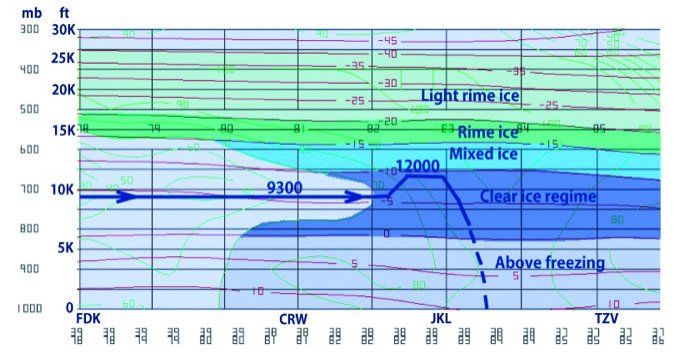Cool Tool
Thank you for a great publication. It really helps knock some rust off. My question is for Tim Vasquez: Where did you get that chart shown on page 22 of the April issue?
As a SPIFR EMS helicopter pilot, icing is my Achilles heel. Not only do I have the same problems as the fixed wing community—weight, reduction of lift etc.—but I also have asymmetric shedding that will tear the aircraft apart rather quickly. Also, as an EMS aircraft, my flights are not very long so I never get above about 3 to 4000 feet.
I have been using the ADDS Tool for a long time but have never seen the chart you show. That thing is amazing! When I use the cross section view and the icing tab, I get a very “pixelated” 3-4 color chart. Nothing like what you showed.

If you could tell me how to get to that chart I would greatly appreciate it. Also, any other recommendations for icing, both current and forecast would be great. When I get a call if I tell them it’s IFR the 10 minutes to launch goes out the window, but they still want me off the ground ASAP.
Steve Shimonek
Terre Haute, IN
The chart was produced by WinGRIDDS:winweather.org. using archived WRF model datasets, and markings were added. This is not really a program geared for casual use and would require a whole additional column to discuss (maybe not of much interest to pilots in general), but I do cover the tool occasionally on my Meteorology Lab YouTube channel and might do a special segment on it soon.However, it is fairly easy to replicate this in real-time with the Aviation Weather Center flight path tool using its cross sections option:www.aviationweather.gov/flightpath2?gis=off. —TV
He’s Still a Politician
In your opening “Remarks” section on page 2 of your April issue you say “Congressman Bill Shuster (D-PA) …” Bill Shuster is actually a Republican. But, you did get it right on page 16 in paragraph 4 of “FAA Score Card.”
Allen Condit
Richardson, TX
Precise Language Matters
I just read in February 2018 Briefing that there were no fatalities for U.S. airlines.
On April 29, 2013, seven crew members perished on a National Airlines 747. I guess cargo doesn’t count, but it sure is real to me.
My son was the first officer.
Terry Brokaw
Location Withheld
First, you have our sincerest condolences on the loss of your son and for our unintended slight.You’re right in that the official statistics for “U.S. Airlines” tend to overlook the cargo airlines and all crew members. We’ve asked the person who summarizes the news for us for that page to try to use more accurate statistics or to qualify them (e.g. “U.S. Passenger Airlines”).
Kudos to Kramer
Every time I read one of Mr. Kramer’s articles about the inner workings of Air Traffic Control, I intend to send a note to say how much I enjoy and benefit from them. Now, at long last, I’m getting the proverbial “roundtuit.”
I’ve been flying GA for 40 years, and have always found ATC to be most helpful and professional, even in my dumbest moments. Mr. Kramer’s articles always illuminate what goes on “behind the scenes,” and have helped me understand how to better interact with ATC.
Please pass my thanks along to him, and thanks to everyone there for the best publication in aviation.
Ken Somers
Bellaire, TX
Thanks for the kind words, Ken. We’ve passed them along. Tarrance is indeed one of our best contributors and never fails to captivate our attention with his excellent prose and his vivid way of bringing things to life for us. We’re lucky to have him.By the way, in this issue we’re introducing a new author who’s also both a pilot and an air traffic controller. See page 15 for his first article. He’s not going to replace Tarrance, but will help out with the grueling month-after-month schedule that Tarrance has had to endure without any backup. Please welcome Elim Hawkins.
What State is That?
I thoroughly enjoyed your May Sim Challenge, “In the Face of the Feds.” However you claim that KDCA is not technically in a state. I believe it is physically located in Arlington, Virginia.
Having spent four years with Naval Intelligence in D.C., I believe that no part of D.C. is west of the river.
The story, as I recall, is that a 10 mile by 10 mile square was ceded for the District by Virginia and Maryland, and formalized by the Residence Act in 1790. About 2/3 is where it presently is—all east of the river—and 1/3 was in present-day Virginia which includes KDCA.
There was an active slave trade in the Virginia portion, and in 1846 the land was returned to Virginia in response to a petition by the residents, who feared the economic hardships that ultimately led to the Civil War. This left what we now know as present-day Washington, D.C., with about 65 square miles. The corner posts are reportedly still in place.
Barry McCollom
Kerrville, TX
Slam Dunk
I just finished reading Stephen Elop’s letter about North Las Vegas (KVGT) in your April Readback. I am based there, so I know those approaches well. With my plane (Cessna 414) I too prefer the longer Runway 12R. I can’t say why, but I’m always brought in very high and fast, making a slam-dunk approach. Fortunately I’m pressurized so I’m not blowing out any eardrums.
I do wish I had spoilers, though. Perhaps one of these days…
Bill Ramos
North Las Vegas, NV
I know what you mean about wanting spoilers. Yes, pressurization helps when ATC gives you the ol’ slam dunk, but when the deck angle approaches -10 degrees and you struggle with speed control, even the most seasoned passengers can get uneasy.You say it routinely happens to you. My best advice is simply to call the approach control who keeps you up there and ask. Knowing why might suggest an alternative. If you can’t work one out, and if many of your local pilots have the same issues, consider a community meeting with the facility to see if something can be worked out. Also consider getting your local FAAST team involved.Let us know how it works out and if you’re able to find a solution. —FBWe read ’em all and try to answer most e-mail, but it can take a month or more. Please be sure to include your full name and location. Contact us at[email protected].




